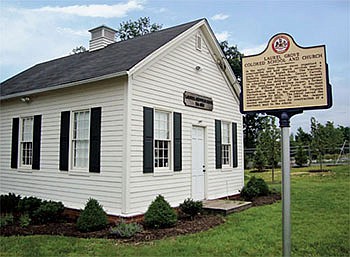Two miles from the non-stop Beltway/Interstate 95-495 stands a one-room, one-level, wooden building with dark green shutters on Beulah Street, in the shadow of the 37-acre, looming MetroPark commercial campus, a multi-story complex with glassy, turquoise windows. The little white building is the Laurel Grove School Museum built in 1884 and once flanked by a laurel grove. This seemingly out-of-place structure, sitting amid Fairfax County’s sprawl, is the only surviving one-room school built for African Americans in Northern Virginia.
Phyllis Walker Ford’s enslaved great-grandparents, William and Georgianna Jasper, deeded one-half acre of their farm to the segregated, then-called Mount Vernon School District for $10.00 in 1881. In 1884, they deeded another half-acre to build the Laurel Grove Baptist Church next door.
The local public school system did not build the Laurel Grove Colored School. Local African-American families contributed money, wood and labor and built it themselves at a time when Virginia’s public schools, by law, were racially segregated. The families found textbooks and recruited a teacher. Fairfax County provided one cord of wood a year.
Fairfax County closed the school in 1933 and auctioned off its contents. The building sat there until 2000 when the Jaspers’ descendants sold 13 acres to the Fried Companies to build MetroPark. When the developers’ title search revealed the property’s history, Mark and Barbara Fried decided to restore the school. They ripped out drywall, a kitchen and bathroom and formed the Laurel Grove School Association in 2002.
The Laurel Grove Colored School seated 22 to 28 students in grades one through seven. In its last year, 1932, before being absorbed into the public school system, it had seven students. Some students walked five miles one way to get to and from school.
A 1920s Classroom
Today, the Laurel Grove School Museum, the blackboards, wooden and wrought iron desks, an iron wood stove and oil lamps represent the 1920s. The museum has several documents, including an inventory recorded by the Jaspers’ owner, William Foote, which says, “one negro man Henry $350; one old negro man Aaron, $10.”
The newest museum possession is a replica of the county’s historical marker for Carrolltown, an African-American community near today’s Hayfield and Old Telegraph Road. Some of the school’s students lived in Carrolltown. The actual marker is on Kingstowne Village Boulevard.
Next door to the museum is a half-acre cemetery with 75 graves. A few cement tombstones remain with hand-lettered, weathered inscriptions, perhaps scrawled into wet cement. One has a cross and records the passing of “Mr. Edgar Harris, BORN May 15th 1876 and DIEd May 19th 1961.” For years, the name, “Moses Harris,” was barely legible on another. Ford led an effort this year to research the people buried there, some of whom were born into slavery. Volunteers from the National Council of Negro Women helped clean the tombstones.
Much of the history of African Americans in Northern Virginia, like the history of enslaved people and minorities in many places, is gone. The region’s relentless development has paved over and swallowed up much of it. Some history was never recorded.
Sustaining a Legacy
To museum director Ford, preserving the school’s legacy is a very personal mission. Her great-grandfather, Jasper, was enslaved on the Foote Farm in the Hayfield area and freed in 1846. In 1860, he bought 13 acres from a white slave owner.
Ford explains that when freed, many former enslaved people did not move away but stayed in the Franconia area. “Jasper purchased land less than two miles from where he was enslaved. “Whites and blacks lived side by side and got along,” she maintains, unlike some more racially-segregated communities.
Virginia’s schools were racially segregated since their beginning in 1870. “State and local officials . . . generally resisted efforts to bring about desegregation and utilized their political power to avoid and then minimize public school desegregation,” according to Encyclopedia Virginia. State elected officials in 1956 adopted an official racial segregation policy in 1956 known as “massive resistance,” opposed to the 1954 U.S. Supreme Court decision in Brown v. Board of Education of Topeka, Kansas, that mandated school desegregation. Desegregation in the state began in 1959 and continued through the early 1970s.
A retired human resources professional and Clifton resident, Ford grew up in the Franconia area of Fairfax County. She attended the county’s segregated public schools and rode 20 miles each way daily past white schools. She graduated from Luther Jackson, then Fairfax County’s “black high school.”
Today, she conducts tours for school groups. On June 3, the Youth Council of the Fairfax County chapter of the NAACP, youngsters ages 13 to 18, visited the museum. “We want them to be informed, to know history,” said Anita Gill-Anderson, Director of Programming for the group. A retired Loudoun County teacher, Gill-Anderson stressed, “It is important to teach the importance of education, not just why it’s important today but in years past. Education will carry you places if you take it seriously.”
Ford believes that the museum can be especially meaningful to Fairfax County fourth grade students who study slavery and reconstruction and high school students who can choose African American history as an elective.
Ford’s parents and brother are buried in the cemetery. The laurel grove once around the school is long gone, but the school’s spirit lives on. To her, Laurel Grove School represents her ancestors’ resiliency and passion for an education. She wants others to better understand slavery, Jim Crow, segregation and their consequences. “We are still uncovering and learning,” Ford says. “The school motto, ‘Get an education and everything will fall into place,’ is still important today.”
Seeking Descendants
In September, the museum will host a family reunion and is seeking descendants who attended the school and church. The event will be open to the public.
Information: http://laurelgroveschool.org/; open Tuesday, Thursday and Saturday, 10 a.m. to 2 p.m.